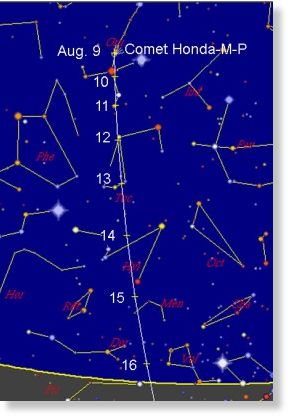
Honda belongs to the short-period Jupiter family of comets or those with orbits less than 20 years under the control of the gravitational powerhouse Jupiter. As it orbits the sun with a period of 5.3 years, it occasionally makes close passes to the planets Venus, Earth and Jupiter. When near Jupiter, the planet's powerful gravity can alter the comet's orbit and change its period slightly. This last occurred in 1983 and will again in 2030.

When I saw the Comet Honda-M-P, it was very faint in a large amateur telescope (15-inch). Today it's brighter at magnitude 8.5 with a coma or cometary atmosphere measuring about half the size of the full moon.
If you're worried that Earth might pass through the coma, don't be. At Honda's present distance of 9.3 million miles, the hazy glow around the tiny cometary nucleus is about 43,000 miles across, much too small to reach out and brush our planet. Even if we did pass through a comet's outer coma, its effects would likely amount to a nice show of meteors at best. Comas are highly rarefied - any ice, dust or small rocks would quickly vaporize on striking the upper atmosphere.
The closer a celestial object is to Earth, the faster it appears to move across the sky. Because the comet is closing in on minimum distance from Earth, it's quickly picking up speed, covering more and more ground as we approach the 15th. Tonight for instance, it travels some two degrees or four times the full moon's diameter in the southern constellation of Grus the Crane. Tomorrow that increases to three degrees, and by the 14-15th, Honda-M-P flys across some 10 degrees of sky- your clenched fist held at arm's length - in just one night!
The next night or two, the comet will still be visible from the far southern states low in the south around 1 a.m., but by the 14th, only southern hemisphere observers will see it. To spot the comet, you'll need at least a small telescope, since it's very diffuse and will get no brighter than 8th magnitude. The moon will also be near or at full phase, lighting up the sky and making it even harder to find.
After closest approach, Honda-M-P swings back north and slowly continues to brighten, reaching 6th magnitude (naked eye limit) in late September, and finally appearing in the morning sky before dawn for northern hemisphere sky watchers in early October. It's expected to be an easy binocular comet then, shining around 7th magnitude.
On the morning of the Oct. 7, it will be joined by Comet Elenin four degrees (eight full moons) to its north. Although both comets will be at different distances from Earth - 90 million miles for Honda-M-P and 22 million for Elenin - they'll lie in approximately the same line of sight. With wide-field binoculars you'll be able to catch them both in the same field of view. What a wonderful and rare sight this will be!
Speaking of Comet Elenin, southern observers continue to observe and photograph it. It's now magnitude 9 with a 3-4 arc minute coma and visible in 4-inch and larger telescopes. Click HERE for the latest views of the comet with the STEREO-B (behind) solar telescope.




Wonder if we can expect some electrical discharge effects?